Uranium Removal from Groundwater and Wastewater Using Clay-Supported Nanoscale Zero-Valent Iron
Abstract
1. Introduction
2. Materials and Methods
3. Results
4. Conclusions
Author Contributions
Funding
Acknowledgments
Conflicts of Interest
References
- Merkel, B.; Schipek, M. (Eds.) The New Uranium Mining Boom; Springer: Berlin/Heidelberg, Germany, 2011; 848p, ISBN 978-3-642-22122-4. [Google Scholar]
- Liu, B.; Peng, T.; Hong-Juan, S.; Yue, H. Release behavior of uranium in uranium mill tailings under environmental conditions. J. Environ. Radioact. 2017, 171, 160–168. [Google Scholar] [CrossRef] [PubMed]
- Selvakumar, R.; Ramadoss, G.; Menon, M.P.; Rajendran, K.; Thavamani, P.; Naidu, R.; Megharaj, M. Challenges and complexities in remediation of uranium contaminated soils: A review. J. Environ. Radioact. 2018, 192, 592–603. [Google Scholar] [CrossRef] [PubMed]
- Yin, M.; Sun, J.; Chen, Y.; Wang, J.; Shang, J.; Belshaw, N.; Shen, C.; Liu, J.; Li, H.; Linghu, W.; et al. Mechanism of uranium release from uranium mill tailings under long-term exposure to simulated acid rain: Geochemical evidence and environmental implication. Environ. Pollut. 2019, 244, 174–181. [Google Scholar] [CrossRef] [PubMed]
- Neiva, A.; Antunes, I.; Carvalho, P.C.S.; Santos, A. Uranium and arsenic contamination in the former Mondego Sul uranium mine area, Central Portugal. J. Geochem. Explor. 2016, 162, 1–15. [Google Scholar] [CrossRef]
- Bernhard, G.; Geipel, G.; Brendler, V.; Nitsche, H. Uranium speciation in waters of different uranium mining areas. J. Alloy. Compd. 1998, 201–205. [Google Scholar] [CrossRef]
- Mühr-Ebert, E.; Wagner, F.; Walther, C. Speciation of uranium: Compilation of a thermodynamic database and its experimental evaluation using different analytical techniques. Appl. Geochem. 2019, 100, 213–222. [Google Scholar] [CrossRef]
- Myasoyedova, G.V.; Nikashyna, V.A. Sorption materials fort he extraction of radionuclides from aqueous media. Russ. Chem. J. 2006, 50, 55–63. [Google Scholar]
- Krajňák, A.; Viglašová, E.; Galamboš, M.; Krivosudský, L. Application of HDTMA-intercalated bentonites in water waste treatment for U(VI) removal. J. Radioanal. Nucl. Chem. 2017, 314, 2489–2499. [Google Scholar] [CrossRef]
- Krajnák, A.; Viglašová, E.; Galamboš, M.; Krivosudský, L. Kinetics, thermodynamics and isotherm parameters of uranium(VI) adsorption on natural and HDTMA-intercalated bentonite and zeolite. Desalin. Water Treat. 2018, 127, 272–281. [Google Scholar] [CrossRef]
- Kornilovych, B.; Wireman, M.; Caruso, B.; Koshik, Y.; Pavlenko, V.; Tobilko, V. The use of permeable reactive barrier against contaminated groundwater in Ukraine. Central Eur. J. Occup. Environ. Med. 2009, 15, 73–85. [Google Scholar]
- Interstate Technology & Regulatory Council. Permeable Reactive Barriers: Technology Update. PRB-5; Interstate Technology & Regulatory Council, PRB; Technology Update Team: Washington, DC, USA, 2011; Available online: www.itrcweb.org (accessed on 17 September 2020).
- Zhang, W.-X. Nanoscale Iron Particles for Environmental Remediation: An Overview. J. Nanoparticle Res. 2003, 5, 323–332. [Google Scholar] [CrossRef]
- Fu, F.; Dionysiou, D.; Liu, H. The use of zero-valent iron for groundwater remediation and wastеwater treatment: A review. J. Hazard. Mater. 2014, 267, 194–205. [Google Scholar] [CrossRef]
- Zou, Y.; Wang, X.; Khan, A.; Wang, P.; Liu, Y.; Alsaedi, A.; Hayat, T.; Wang, X. Environmental Remediation and Application of Nanoscale Zero-Valent Iron and Its Composites for the Removal of Heavy Metal Ions: A Review. Environ. Sci. Technol. 2016, 50, 7290–7304. [Google Scholar] [CrossRef] [PubMed]
- Chen, A.; Shang, C.; Shao, J.; Zhang, J.; Huang, H. The application of iron-based technologies in uranium remediation: A review. Sci. Total. Environ. 2017, 575, 1291–1306. [Google Scholar] [CrossRef]
- Jing, C.; Li, Y.; Landsberger, S. Review of soluble uranium removal by nanoscale zero valent iron. J. Environ. Radioact. 2016, 164, 65–72. [Google Scholar] [CrossRef] [PubMed]
- Jiang, D.; Zeng, G.; Huang, D.; Chen, M.; Zhang, C.; Huang, C.; Wan, J. Remediation of contaminated soils by enhanced nanoscale zero valent iron. Environ. Res. 2018, 163, 217–227. [Google Scholar] [CrossRef]
- Tosco, T.; Papini, M.P.; Viggi, C.C.; Sethi, R. Nanoscale zerovalent iron particles for groundwater remediation: A review. J. Clean. Prod. 2014, 77, 10–21. [Google Scholar] [CrossRef]
- Zhao, X.; Liu, W.; Cai, Z.; Han, B.; Qian, T.; Zhao, D. An overview of preparation and applications of stabilized zero-valent iron nanoparticles for soil and groundwater remediation. Water Res. 2016, 100, 245–266. [Google Scholar] [CrossRef] [PubMed]
- Trujillo-Reyes, J.; Peralta-Videa, J.; Gardea-Torresdey, J.L. Supported and unsupported nanomaterials for water and soil remediation: Are they a useful solution for worldwide pollution? J. Hazard. Mater. 2014, 280, 487–503. [Google Scholar] [CrossRef]
- Liu, Z.; Zhang, F.; Hoekman, S.K.; Liu, T.; Gai, C.; Peng, N. Homogeneously Dispersed Zerovalent Iron Nanoparticles Supported on Hydrochar-Derived Porous Carbon: Simple, in Situ Synthesis and Use for Dechlorination of PCBs. ACS Sustain. Chem. Eng. 2016, 4, 3261–3267. [Google Scholar] [CrossRef]
- Petala, E.; Dimos, K.; Douvalis, A.; Bakas, T.; Tucek, J.; Zbořil, R.; Karakassides, M.A. Nanoscale zero-valent iron supported on mesoporous silica: Characterization and reactivity for Cr(VI) removal from aqueous solution. J. Hazard. Mater. 2013, 261, 295–306. [Google Scholar] [CrossRef] [PubMed]
- Sun, Z.; Zheng, S.; Ayoko, G.A.; Frost, R.L.; Xi, Y. Degradation of simazine from aqueous solutions by diatomite-supported nanosized zero-valent iron composite materials. J. Hazard. Mater. 2013, 263, 768–777. [Google Scholar] [CrossRef]
- Yua, S.; Wangab, X.; Liua, Y.; Chena, Z.; Wua, Y.; Liua, Y.; Panga, H.; Songc, G.; Chen, J.; Wang, X. Efficient removal of uranium(VI) by layered double hydroxides supported nanoscale zero-valent iron: A combined experimental and spectroscopic studies. Chem. Eng. J. 2019, 365, 51–59. [Google Scholar] [CrossRef]
- Ding, C.; Cheng, W.; Nie, X.; Yi, F.; Xiang, S.; Asiri, A.M.; Marwani, H.M. Reactivity of carbonized fungi supported nanoscale zero-valent iron toward U(VI) influenced by naturally occurring ions. J. Ind. Eng. Chem. 2018, 61, 236–243. [Google Scholar] [CrossRef]
- Lv, X.; Xue, X.; Jiang, G.; Wu, D.; Sheng, T.; Zhou, H.; Xinhua, X. Nanoscale Zero-Valent Iron (nZVI) assembled on magnetic Fe3O4/graphene for Chromium (VI) removal from aqueous solution. J. Colloid Interface Sci. 2014, 417, 51–59. [Google Scholar] [CrossRef] [PubMed]
- Tan, L.; Wang, Y.; Liu, Q.; Wang, J.; Jing, X.; Liu, L.; Liu, J.; Song, D. Enhanced adsorption of uranium (VI) using a three-dimensional layered double hydroxide/graphene hybrid material. Chem. Eng. J. 2015, 259, 752–760. [Google Scholar] [CrossRef]
- Kurniawan, T.A.; Chan, G.Y.; Lo, W.-H.; Babel, S. Comparisons of low-cost adsorbents for treating wastewaters laden with heavy metals. Sci. Total. Environ. 2006, 366, 409–426. [Google Scholar] [CrossRef]
- Misaelides, P. Clay minerals and zeolites for radioactive waste immobilization and containment. Modif. Clay Zeolite Nanocomposite Mater. 2019, 243–274. [Google Scholar] [CrossRef]
- Ezzatahmadi, N.; Ayoko, G.A.; Millar, G.J.; Speight, R.; Yan, C.; Li, J.; Li, S.; Zhu, J.; Xi, Y. Clay-supported nanoscale zero-valent iron composite materials for the remediation of contaminated aqueous solutions: A review. Chem. Eng. J. 2017, 312, 336–350. [Google Scholar] [CrossRef]
- Üzüm, Ç.; Shahwan, T.; Eroğlu, A.E.; Hallam, K.R.; Scott, T.B.; Lieberwirth, I. Synthesis and characterization of kaolinite-supported zero-valent iron nanoparticles and their application for the removal of aqueous Cu2+ and Co2+ ions. Appl. Clay Sci. 2009, 43, 172–181. [Google Scholar] [CrossRef]
- Shahwan, T.; Üzüm, Ç.; Eroğlu, A.E.; Lieberwirth, I. Synthesis and characterization of bentonite/iron nanoparticles and their application as adsorbent of cobalt ions. Appl. Clay Sci. 2010, 47, 257–262. [Google Scholar] [CrossRef]
- Bhowmick, S.; Chakrabarti, S.; Mondal, P.; Van Renterghem, W.; Berghe, S.V.D.; Roman-Ross, G.; Chatterjee, D.; Iglesias, M. Montmorillonite-supported nanoscale zero-valent iron for removal of arsenic from aqueous solution: Kinetics and mechanism. Chem. Eng. J. 2014, 243, 14–23. [Google Scholar] [CrossRef]
- Jing, C.; Landsberger, S.; Li, Y. The application of illite supported nanoscale zero valent iron for the treatment of uranium contaminated groundwater. J. Environ. Radioact. 2017, 175, 1–6. [Google Scholar] [CrossRef]
- Zhdanyuk, N.V.; Kovalchuk, I.A.; Kornilovych, B.Y. Sorption of uranium (VI) and cobalt (II) ions by iron-containing nanocomposites based on palygorskite. Surface Chem. Phys. Techn. 2019, 10, 48–58. [Google Scholar] [CrossRef]
- Rouquerol, F.; Rouquerol, J.; Sing, K.S.W.; Llewellyn, P.; Maurin, G. Adsorption by Powders and Porous Solids; Elsevier: Amsterdam, The Netherlands, 2014; ISBN 9780080970356. [Google Scholar]
- Shi, L.-N.; Lin, Y.-M.; Zhang, X.; Chen, Z.-L. Synthesis, characterization and kinetics of bentonite supported nZVI for the removal of Cr(VI) from aqueous solution. Chem. Eng. J. 2011, 171, 612–617. [Google Scholar] [CrossRef]
- Tobilko, V.Y.; Kornilovych, B.Y. Synthethis and sorption properties of composite materials based on nanoscale Fe. East. Eur. J. Enterp. Technol. 2015, 4, 22–27. [Google Scholar]
- Kornilovych, B.; Wireman, M.; Ubaldini, S.; Guglietta, D.; Koshik, Y.; Caruso, B.; Kovalchuk, I. Uranium Removal from Groundwater by Permeable Reactive Barrier with Zero-Valent Iron and Organic Carbon Mixtures: Laboratory and Field Studies. Metals 2018, 8, 408. [Google Scholar] [CrossRef]
- Bergaya, F.; Theng, B.K.; Lagaly, G. Handbook of Clay Science; Elsevier: London, UK, 2006; 1246p, ISBN 9780080441832. [Google Scholar]
- Sposito, G. The Surface Chemistry of Soils; Oxford University Press: Oxford, UK, 1984; 344p, ISBN 9780195313697. [Google Scholar]
- Crane, R.; Pullin, H.; Scott, T. The influence of calcium, sodium and bicarbonate on the uptake of uranium onto nanoscale zero-valent iron particles. Chem. Eng. J. 2015, 277, 252–259. [Google Scholar] [CrossRef]
- Chekli, L.; Bayatsarmadi, B.; Sekine, R.; Sarkar, B.; Shen, A.M.; Scheckel, K.G.; Skinner, W.; Naidu, R.; Shon, H.K.; Lombi, E.; et al. Analytical characterisation of nanoscale zero-valent iron: A methodological review. Anal. Chim. Acta 2016, 903, 13–35. [Google Scholar] [CrossRef]
- Sheng, G.; Shao, X.; Li, Y.; Li, J.; Dong, H.; Cheng, W.; Gao, X.; Huang, Y. Enhanced Removal of Uranium(VI) by Nanoscale Zerovalent Iron Supported on Na–Bentonite and an Investigation of Mechanism. J. Phys. Chem. A 2014, 118, 2952–2958. [Google Scholar] [CrossRef]
- Kornilovich, B.Y.; Pshinko, G.N.; Bogolepov, A.A. Effects of EDTA and NTA on sorption of U(VI) on the clay fraction of soil. Radiochemistry 2006, 48, 584–588. [Google Scholar] [CrossRef]
- Altmaier, M.; Yalçıntaş, E.; Gaona, X.; Neck, V.; Müller, R.; Schlieker, M.; Fanghänel, T. Solubility of U(VI) in chloride solutions. I. The stable oxides/hydroxides in NaCl systems, solubility products, hydrolysis constants and SIT coefficients. J. Chem. Thermodyn. 2017, 114, 2–13. [Google Scholar] [CrossRef]
- Galan, E.; Singer, A. (Eds.) Developments in Palygorskite-Sepiolite Research; Galan, E.; Singer, A. (Eds.) Elsevier: Amsterdam, The Netherlands, 2011; Volume 3, 520p, ISBN 9780444536075. [Google Scholar]
- Puigdomènech, I.; Colas, E.; Glive, M.; Campos, I.; Garcia, D. A tool to draw chemical equilibrium diagrams using SIT: Applications to geochemical systems and radionuclide solubility. MRS Online Proc. Libr. Arch. 2014, 1665, 111–116. [Google Scholar] [CrossRef]
- Fujiwara, K.; Yamana, H.; Fujii, T.; Kawamoto, K.; Sasaki, T.; Moriyama, H. Solubility Product of Hexavalent Uranium Hydrous Oxide. J. Nucl. Sci. Technol. 2005, 42, 289–294. [Google Scholar] [CrossRef]
- Kramer-Schnabel, U.; Bischoff, H.; Xi, R.H.; Marx, G. Solubility Products and Complex Formation Equilibria in the Systems Uranyl Hydroxide and Uranyl Carbonate at 25°C and I = 0.1 M. Radiochim. Acta 1992, 56, 183–188. [Google Scholar] [CrossRef]
- Prentice Hall; Langmuir, D. Aqueous Environmental Geochemistry; Prentice Hall: Upper Saddle River, NJ, USA, 1997; 600p, ISBN 13-978-0023674129. [Google Scholar]
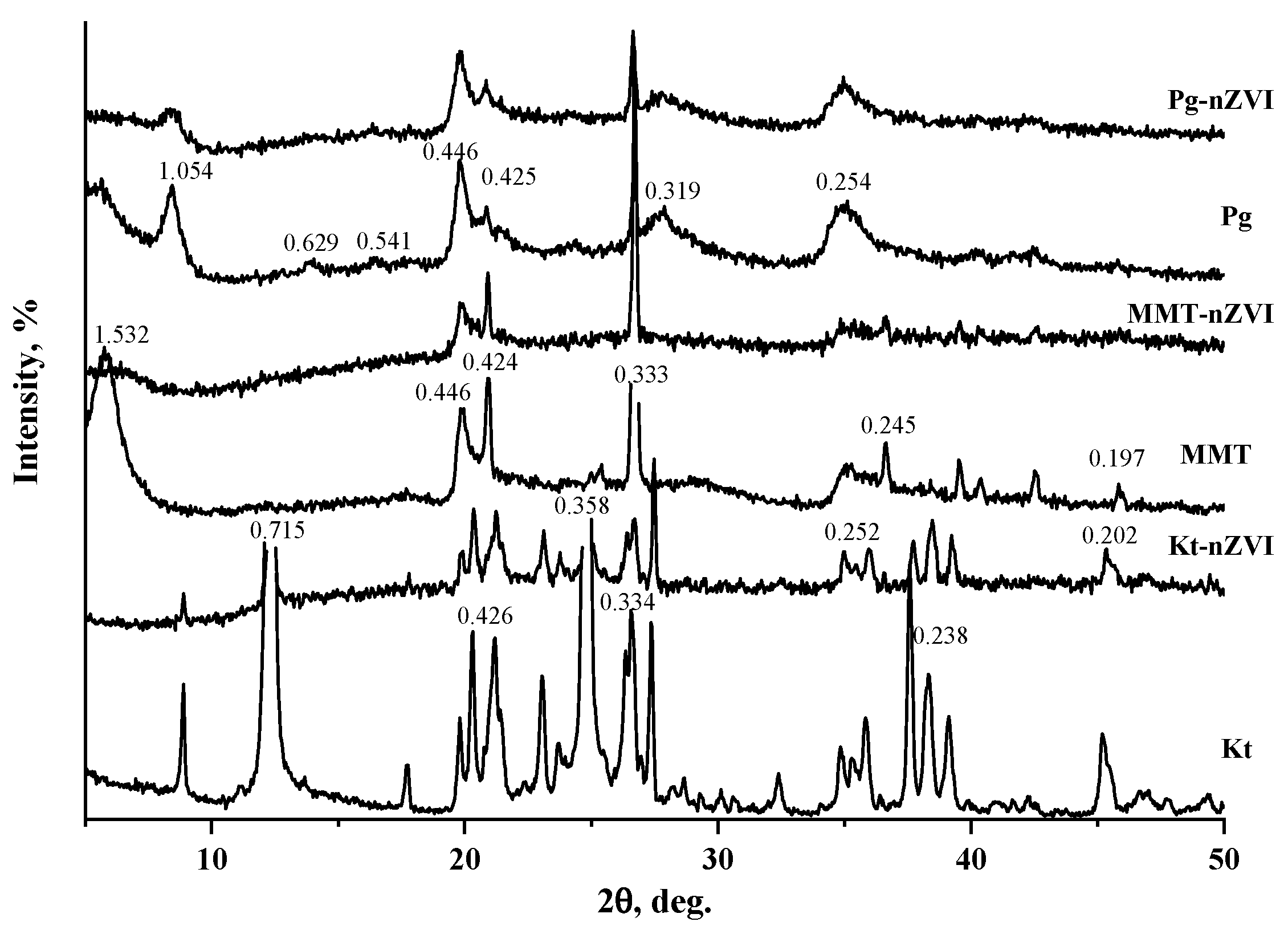
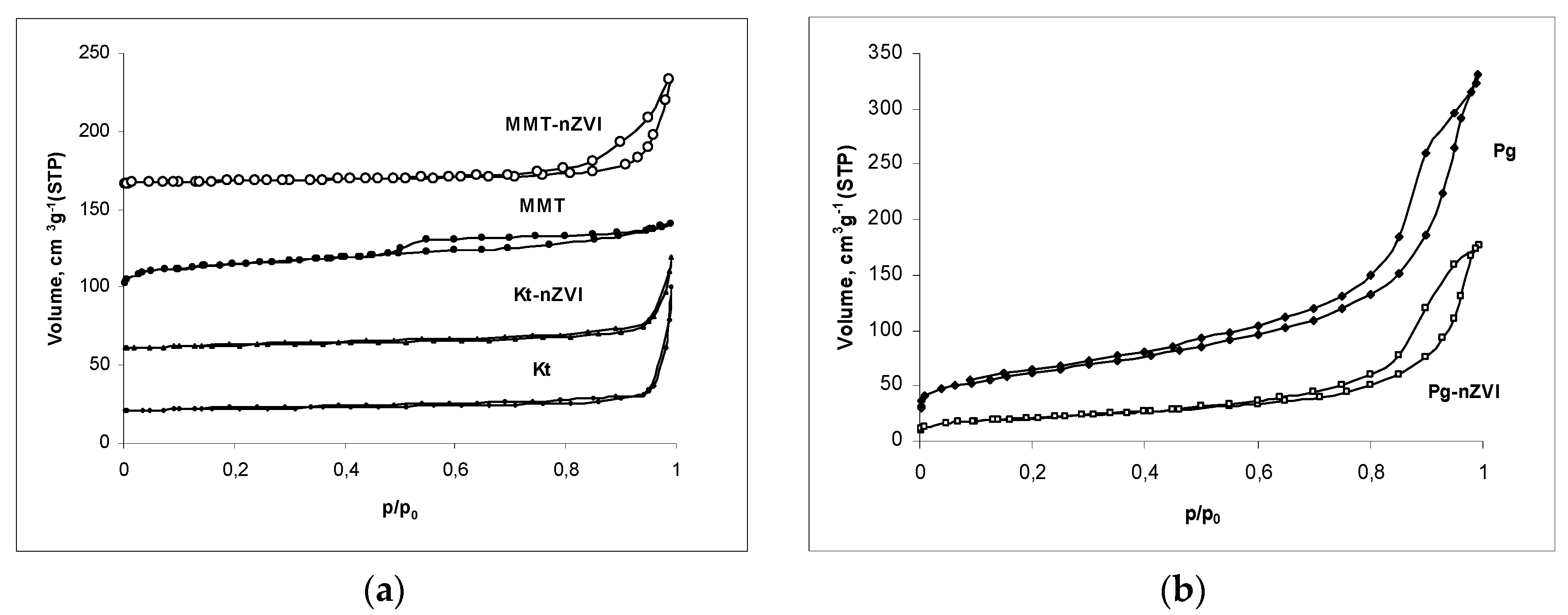
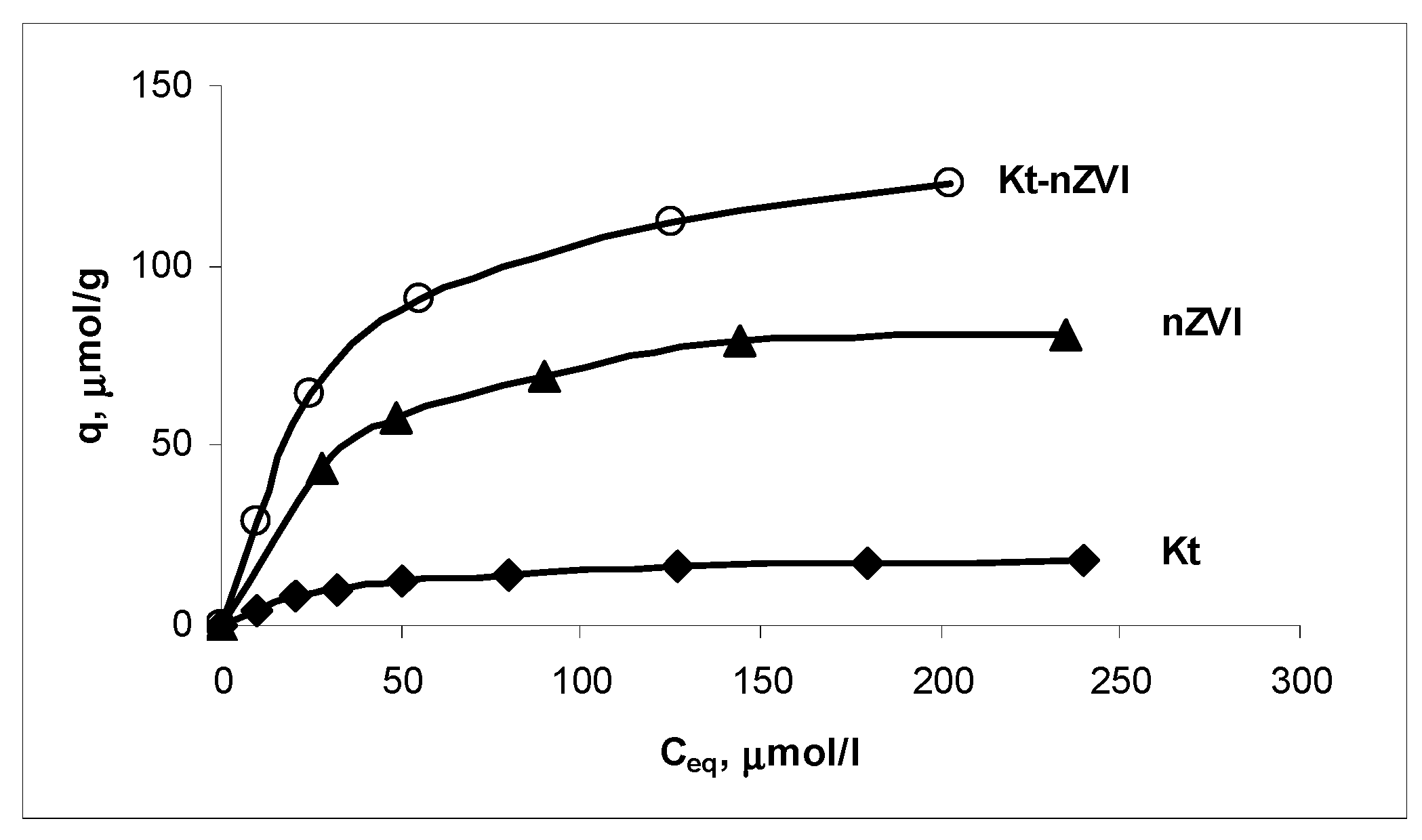
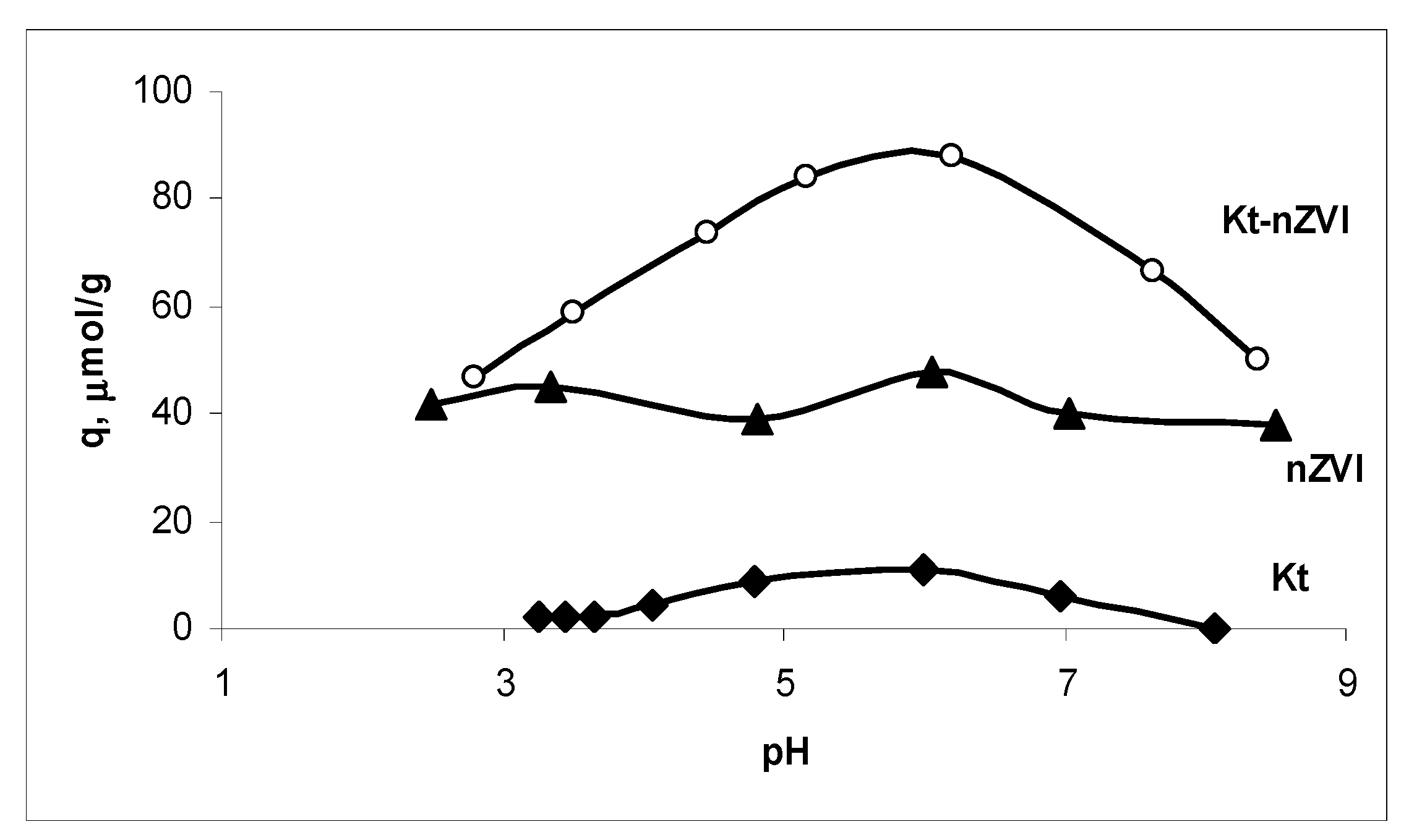


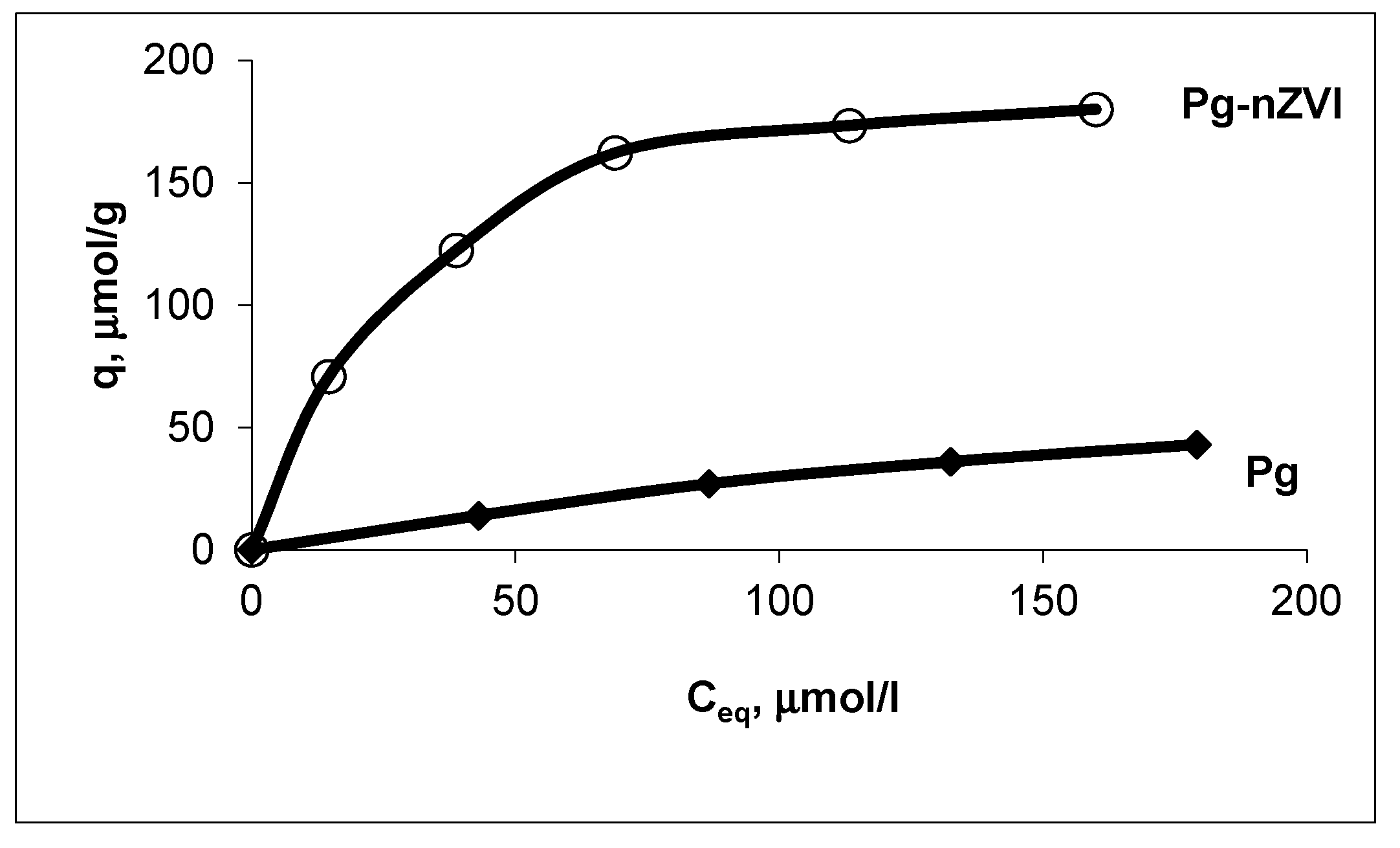
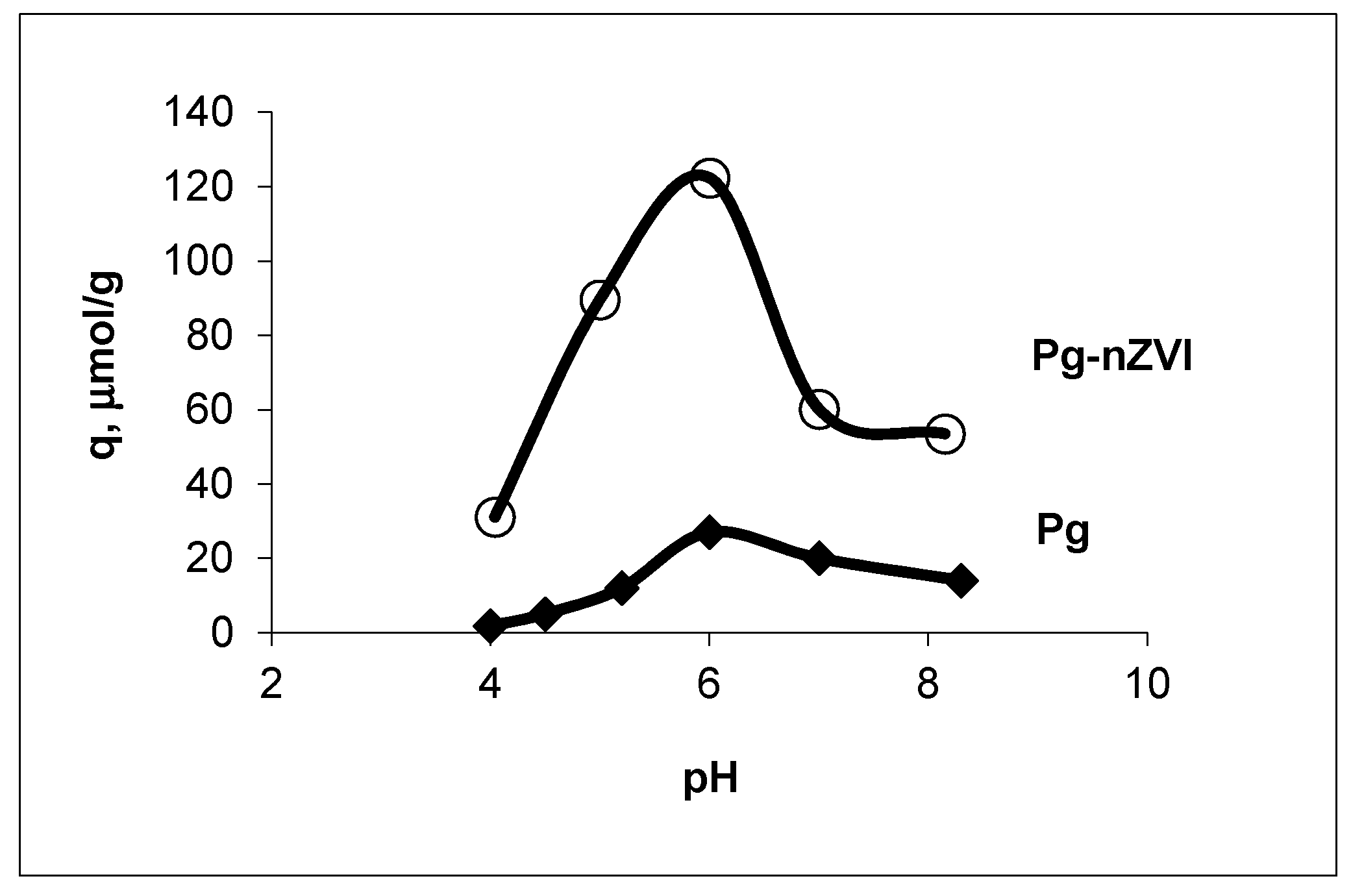

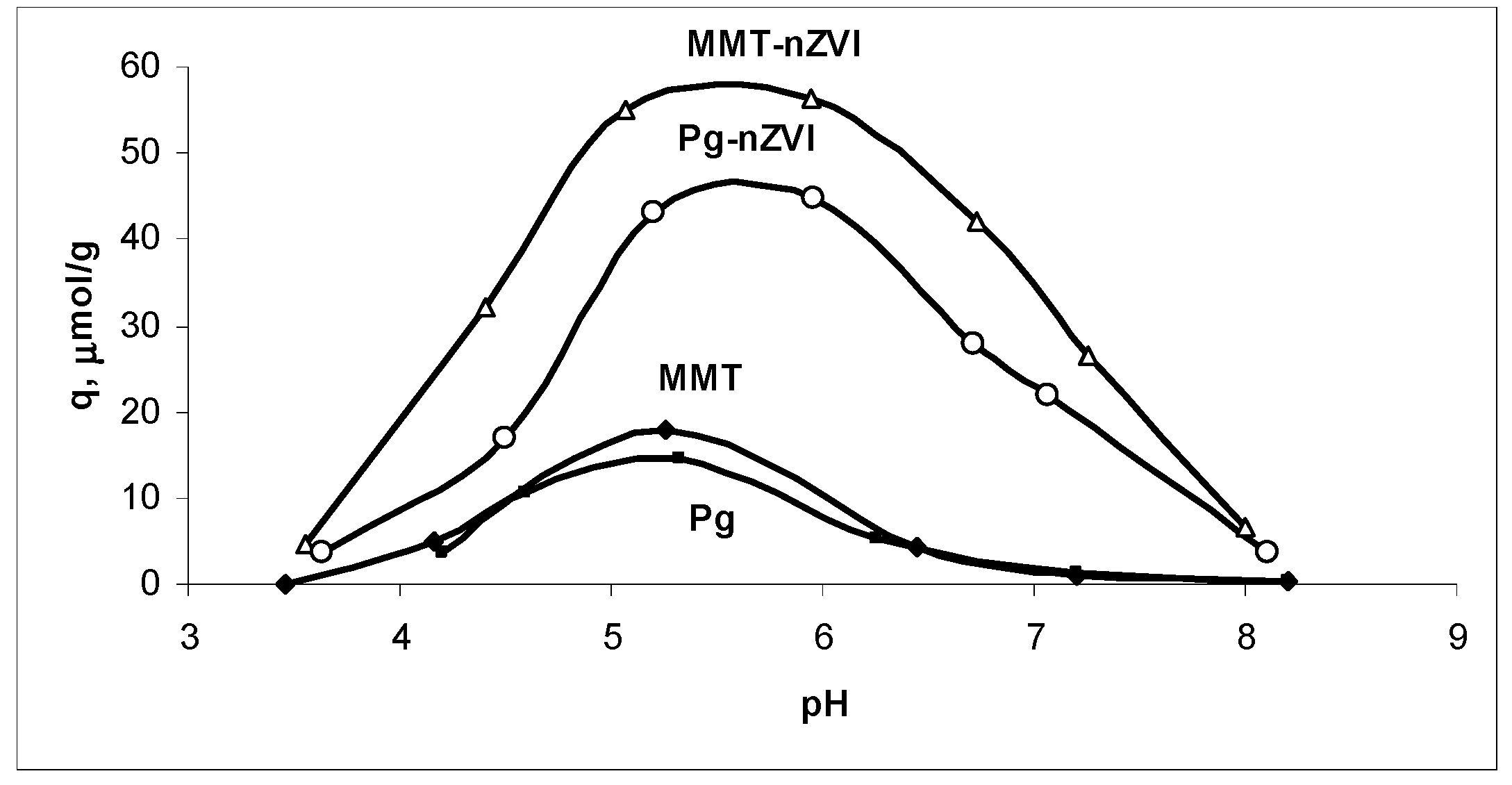

| Sample | S, m2/g | V∑, cm3/g | Vμ, cm3/g | Vμ%, % | Distribution of Pore Size, nm | |||
|---|---|---|---|---|---|---|---|---|
| BJH dV (r) | DFT dV (r) | |||||||
| r1 | r2 | r1 | r2 | |||||
| Kaolinite | 8.98 | 0.124 | 0.003 | 2.1 | - | - | 2.36 | 4.91–8.58 |
| Kaolinite-nZVI | 11.72 | 0.093 | 0.003 | 3.1 | - | - | 2.51 | 2.63–3.52 |
| Montmorillonite | 89.11 | 0.081 | 0.016 | 19.8 | 1.41 | - | 1.91 | 2.82 |
| Montmorillonite-nZVI | 24.74 | 0.384 | 0.008 | 2.1 | 2.11 | - | 2.84 | 8.96 |
| Palygorskite | 213.15 | 0.512 | 0.084 | 16.6 | 1.90 | 6.26 | - | - |
| Palygorskite-nZVI | 71.68 | 0.274 | 0.002 | 0.8 | 8.89 | - | 6.73 | 8.64–9.95 |
| Sample | MMT | MMT-nZVI | Pg | Pg-nZVI |
|---|---|---|---|---|
| Langmuir | ||||
| a∞, μmol g−1 | 125 | 452 | 59 | 325 |
| KL, L μmol−1 | 0.0084 | 0.1093 | 0.0096 | 0.1221 |
| R2 | 0.956 | 0.964 | 0.975 | 0.938 |
| Freundlich | ||||
| KF | 5.3 | 92.0 | 3.2 | 116.5 |
| 1/n | 1.97 | 3.28 | 2.13 | 3.35 |
| R2 | 0.887 | 0.825 | 0.850 | 0.892 |
Publisher’s Note: MDPI stays neutral with regard to jurisdictional claims in published maps and institutional affiliations. |
© 2020 by the authors. Licensee MDPI, Basel, Switzerland. This article is an open access article distributed under the terms and conditions of the Creative Commons Attribution (CC BY) license (http://creativecommons.org/licenses/by/4.0/).
Share and Cite
Kornilovych, B.; Kovalchuk, I.; Tobilko, V.; Ubaldini, S. Uranium Removal from Groundwater and Wastewater Using Clay-Supported Nanoscale Zero-Valent Iron. Metals 2020, 10, 1421. https://doi.org/10.3390/met10111421
Kornilovych B, Kovalchuk I, Tobilko V, Ubaldini S. Uranium Removal from Groundwater and Wastewater Using Clay-Supported Nanoscale Zero-Valent Iron. Metals. 2020; 10(11):1421. https://doi.org/10.3390/met10111421
Chicago/Turabian StyleKornilovych, Borys, Iryna Kovalchuk, Viktoriia Tobilko, and Stefano Ubaldini. 2020. "Uranium Removal from Groundwater and Wastewater Using Clay-Supported Nanoscale Zero-Valent Iron" Metals 10, no. 11: 1421. https://doi.org/10.3390/met10111421
APA StyleKornilovych, B., Kovalchuk, I., Tobilko, V., & Ubaldini, S. (2020). Uranium Removal from Groundwater and Wastewater Using Clay-Supported Nanoscale Zero-Valent Iron. Metals, 10(11), 1421. https://doi.org/10.3390/met10111421






